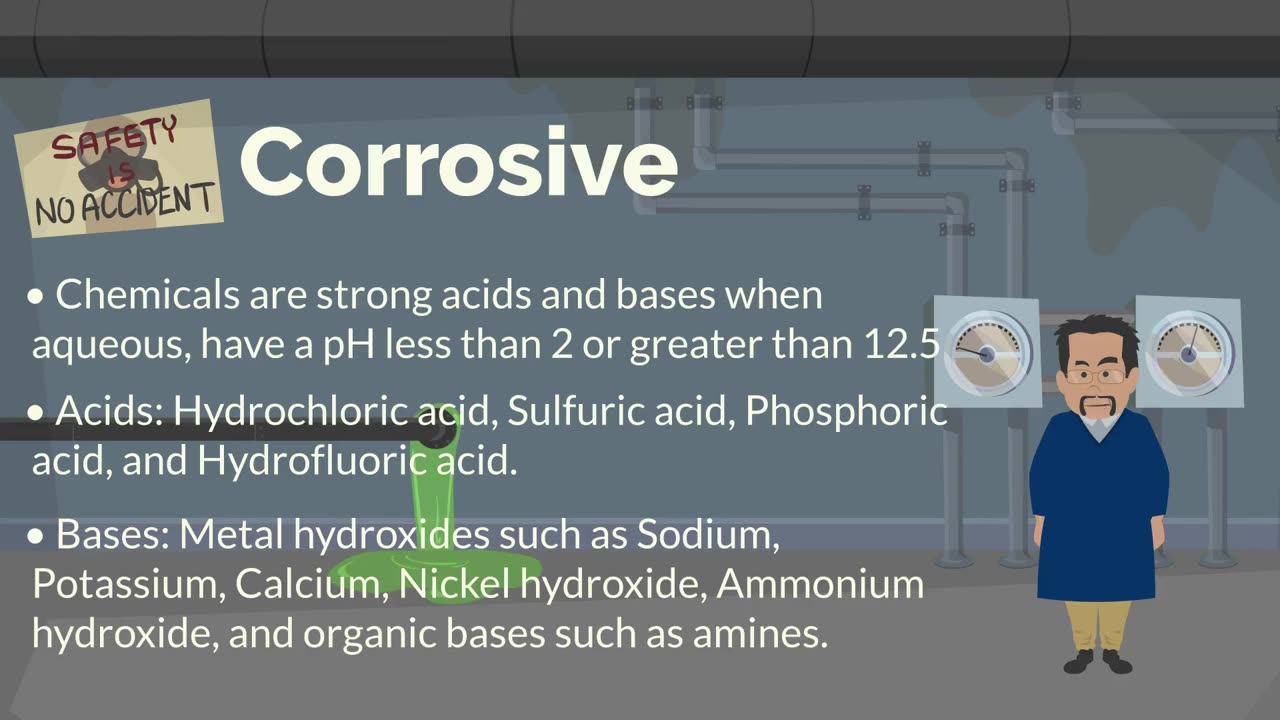Premium Only Content

Chemical Hazard Recognition_ TRIC
**Chemical Hazard Recognition: TRIC**
The acronym **TRIC** can be used as a systematic approach to recognize and address chemical hazards. It stands for **Toxicity, Reactivity, Ignitability, and Corrosivity**. Here's how each component helps in chemical hazard recognition:
---
### **1. Toxicity**
- **Definition**: The potential of a chemical to cause harm to living organisms through inhalation, ingestion, or skin contact.
- **Indicators**:
- Pictograms or labels indicating "Toxic," "Harmful," or "Dangerous."
- Consult the Safety Data Sheet (SDS) for information on lethal doses (LD50) and permissible exposure limits (PEL).
- **Recognition**:
- Examples: Carbon monoxide, cyanide, and pesticides.
- Observe symptoms like dizziness, nausea, or irritation.
---
### **2. Reactivity**
- **Definition**: The chemical's tendency to react violently or release energy when exposed to certain conditions (e.g., heat, water, or other chemicals).
- **Indicators**:
- Terms like "Unstable," "Explosive," or "Reactive" on labels.
- SDS section on stability and reactivity.
- **Recognition**:
- Examples: Sodium reacts with water; peroxides are shock-sensitive.
- Look for storage warnings like "Keep away from heat or incompatible substances."
---
### **3. Ignitability**
- **Definition**: The ability of a chemical to catch fire under certain conditions.
- **Indicators**:
- Flashpoint data on the SDS.
- Flammable or combustible warnings.
- Pictograms like the flame symbol.
- **Recognition**:
- Examples: Gasoline, ethanol, and acetone.
- Check for proper grounding and storage in fire-safe cabinets.
---
### **4. Corrosivity**
- **Definition**: The ability of a chemical to destroy or irreversibly damage materials, including skin and metals.
- **Indicators**:
- Pictograms or warnings indicating "Corrosive."
- SDS sections on handling precautions.
- **Recognition**:
- Examples: Sulfuric acid, sodium hydroxide, and hydrochloric acid.
- Observe physical signs of damage to containers or PPE.
---
### **Application of TRIC in Safety**
1. **Assessment**: Use TRIC to evaluate the potential risks of chemicals during storage, transportation, and usage.
2. **Training**: Educate employees about recognizing hazards and understanding labels and SDS.
3. **Controls**: Implement engineering controls (e.g., fume hoods), administrative controls (e.g., safe work practices), and PPE to mitigate risks.
Would you like this concept expanded into a training presentation or animation script?
-
 20:24
20:24
HSESafetyInformation
9 months agoKABULI PULAO RECIPE - Original 40+ KG Afghani Meat Pulau Prepared - Street Food Qabili Plav Recipe_2
38 -
 LIVE
LIVE
Lofi Girl
3 years agolofi hip hop radio 📚 - beats to relax/study to
210 watching -
 21:23
21:23
Neil McCoy-Ward
18 hours ago🚨 While You Were Distracted TODAY... (This Quietly Happened!!!)
19.6K11 -
 6:09:42
6:09:42
SpartakusLIVE
10 hours agoLIVE from OCEAN FRONT || ENERGIZED Wins and TOXIC Comms
264K18 -
 1:35:45
1:35:45
Tucker Carlson
10 hours agoTucker Puts Piers Morgan’s Views on Free Speech to the Ultimate Test
63.7K326 -
 2:06:16
2:06:16
TheSaltyCracker
10 hours agoMedia Justifies Attack on National Guard ReeEEStream 11-26-25
122K293 -
 3:54:35
3:54:35
Mally_Mouse
13 hours ago🎮 Let's Play!!: Stardew Valley pt. 34
55.6K2 -
 18:25
18:25
MetatronHistory
3 days agoThe REAL Origins of the Macedonians
57K6 -
 1:22:12
1:22:12
MattMorseTV
10 hours ago $180.83 earned🔴It’s MUCH WORSE than WE THOUGHT. 🔴
152K238 -
 7:22:09
7:22:09
Meisters of Madness
14 hours agoOmega Gaiden - Part 4
49K1